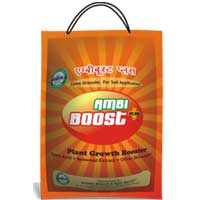
Zyme Granules
Get Price Quote
We offer Zyme Granules that are a storehouse of nutrients. Zyme Granules are based on humic acid, a combination of enzymes, co enzymes, proteins, vitamins, carbohydrate, tiba, folic acid and other ingredients. The Zyme Granules provide extra strength to manipulate the height, branches and width of the plant. The foremost concept is that the plants with multiple branches, height and width, give better yield to the farmer as those plants produce flower and fruits of sizes more than the normal size. Dose 4-8 kg per acre Packing Available 4 kg pouch10 Kg bucket 50 Kg Drum

Azospirillum
Get Price Quote
Azospirillum, Biofertilizers, Gibberellic Acid, tricontanol
Best Deals from Fertilizer

Mycorrhiza Biofertilizer
Get Price Quote
Mycorrhiza Biofertilizer is also known as VAM (Myco = Fungal + rrhiza = roots) adheres to plants rhizoids leading to development of hyphae. Hyphae boost development and spreading of white root in to soil leading to significant increase in rhizosphere. These hyphae further penetrate and form arbuscules within the root cortical. VAM fungi form a special symbiotic relationship with roots of plant that can enhance growth and survivability of colonized plants. Mycorrhiza Biofertilizer is very useful in organic farming as well as normal commercial farming. Advantages Enhanced Uptake of Nutrients and water : extended root-zone facilitates availability of major / micro nutrients and water from untouched layer of the soil. Increased Solubility of Soil Minerals : Facilitates solubiliization of unavailable forms of phosphorus and other nutrients that can be taken up by the plant roots reducing dependence on chemical fertilizers up to 35%. Uniform Plant Growth : Fungal hypae have positive impact on the hydric status and soil aggregation, leading to more uniform plant growth. Improved soil texture & structure with reduced soil erosion : VAM fungi produce chemicals that prevent compaction of the soil particles, making them more porous facilitating root penetration in the soil and increased soil microflora. Thus, better root biomass reduces soil erosion. Secondary disease controlling agent and enhanced resistance to root related diseases : VAM fungi have been reported to be responsible for a transient stimulation of host-plant disease resistance mechanisms. Increase resistance against drought, salinity, heavy metal and other abiotic stresses : VAM fungi are known to scavenge the metal polllutants in the immediate surroundings of then plant roots and accumulating them in the hypae. As the VAM fungi facilitate enhance uptake of water and other nutrients, they help the host plant to overcome adverse soil conditions. Improved Hardiness and ”Transient Transplant Shock’ of Tissue Culture raised Plant : Due to theirability to facilitate better root growth and uptake of nutrients. VAM fungi improve survival frequency of transplanted stocks, and also improves the hardening of tissue culture Increase efficacy of other soil applicable biologica formulation : VAM fungi increase root biomas which is primary requirements for other organisms viz. Rhizobium spp., Trichoderma spp., etc resulting in significant improvement in their functionality and use efficiency. Plant disease resistance induced by arbuscular mycorrhizal fungi Source of Information : Ying Yong Sheng Tai Xue Bao. 2003 May;14(5):819-22. Huang J, Luo S, Zeng R. Author information Abstract : In recent years, the induced disease resistance of plant by Arbuscular Mycorrhizal Fungi (AMF) has become a hot spot in chemo-ecological study and in biocontrol of plant disease. There were many reports indicating that AMF had antagonistic function to soilborne disease pathogen, or could suppress the growth of pathogen, and increase the resistance or tolerance of mycorrhizal plants to soilborne disease. In mycorrhizosphere, there are interactions among microbial community, in which, AMF could suppress the growth of pathogen and promote the growth of beneficial microbe. Thus, AMF may use as biocontrol fungi with other antagonism microbe. There were several hypotheses about the mechanisms of the increased resistance in mycorrhizal plants : Improvement of plant nutrient status; Competition; Changed roots morphology and structure; Changed microbial flora in rhizosphere; Induced resistance or systematic resistance in plant. After colonized by AMF, phenolic compounds accumulate in plant, and local defense response or systemic defense response occurs. It is necessary to do intensive research on the mechanisms of increased resistance in mycorrhizal plants, because it may help us understand the function of disease resistance of mycorrhiza correctly, and let us use AMF as a new biocontrol method to control soilborne disease in eco-agriculture in the near future.PMID : 12924148, [PubMed - indexed for MEDLINE]Available Formulations : 120 I.P./ gram (infective propagules) – for soil applicationRecommended Doses : 5 kg per acre for all crops

Rhizobium
Get Price Quote
Rhizobium, Phosphate Solubilizing Bacteria, Azotobacter

mustard seed oil cake
Get Price Quote
mustard seed oil cake, Kalonji Oil, kalonji seed, Cassia Tora Seeds

Biofertilizers
Get Price Quote
Biofertilizers, Biofungicides

Vermiwash
Get Price Quote
Vermiwash, Worms, pure vermicompost

Copper Sulfate
Get Price Quote
Copper Sulfate, copper fine powder, Zinc Oxide Powder

vermicompost
Get Price Quote
Vermiwash, earthworm manure, live earthworm, Earthworm

Agriculture Vermiculture
Get Price Quote
Agriculture Vermiculture, Ashwagandha Roots, Asaliya Seeds, Isabgol Husk

micronutrient
Get Price Quote
micronutrient, Fungicide, Plant Growth Regulator

Biofertilizers
Get Price Quote
Biofertilizers, psyllium powders, Psyllium Seeds, Oil Seed, Pulses Seeds

vermicompost
Get Price Quote